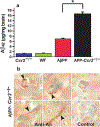The neuroimmune system in Alzheimer's disease: the glass is half full
- PMID: 22751176
- PMCID: PMC8176079
- DOI: 10.3233/JAD-2012-129027
The neuroimmune system in Alzheimer's disease: the glass is half full
Abstract
It is well established that microglia, the neuroimmune cells of the brain, are associated with amyloid-β (Aβ) deposits in Alzheimer's disease (AD). However, the roles of these cells and other mononuclear phagocytes such as monocytes and macrophages in AD pathogenesis and progression have been elusive. Clues to mononuclear phagocyte involvement came with the demonstration that Aβ directly activates microglia and monocytes to produce neurotoxins, signifying that a receptor mediated interaction of Aβ with these cells may be critical for neurodegeneration seen in AD. Also, in AD brain, mononuclear phagocyte distribution changes from a uniform pattern that covers the brain parenchyma to distinct clusters intimately associated with areas of Aβ deposition, but the driving force behind this choreography was unclear. Here, we review our recent work identifying mononuclear phagocyte receptors for Aβ and unraveling mechanisms of recruitment of these cells to areas of Aβ deposition. While our findings and those of others have added significantly to our understanding of the role of the neuroimmune system in AD, the glass remains half full (or half empty) and a lot remains to be uncovered.
Figures


Similar articles
-
β-amyloid, microglia, and the inflammasome in Alzheimer's disease.Semin Immunopathol. 2015 Nov;37(6):607-11. doi: 10.1007/s00281-015-0518-0. Epub 2015 Aug 7. Semin Immunopathol. 2015. PMID: 26251237 Free PMC article. Review.
-
Mechanisms of mononuclear phagocyte recruitment in Alzheimer's disease.CNS Neurol Disord Drug Targets. 2010 Apr;9(2):168-73. doi: 10.2174/187152710791011982. CNS Neurol Disord Drug Targets. 2010. PMID: 20205643 Free PMC article. Review.
-
TLR4 mutation reduces microglial activation, increases Aβ deposits and exacerbates cognitive deficits in a mouse model of Alzheimer's disease.J Neuroinflammation. 2011 Aug 9;8:92. doi: 10.1186/1742-2094-8-92. J Neuroinflammation. 2011. PMID: 21827663 Free PMC article.
-
How to get from here to there: macrophage recruitment in Alzheimer's disease.Curr Alzheimer Res. 2011 Mar;8(2):156-63. doi: 10.2174/156720511795256017. Curr Alzheimer Res. 2011. PMID: 21345166 Free PMC article. Review.
-
Distinct inflammatory phenotypes of microglia and monocyte-derived macrophages in Alzheimer's disease models: effects of aging and amyloid pathology.Aging Cell. 2017 Feb;16(1):27-38. doi: 10.1111/acel.12522. Epub 2016 Oct 8. Aging Cell. 2017. PMID: 27723233 Free PMC article.
Cited by
-
Migration of neutrophils targeting amyloid plaques in Alzheimer's disease mouse model.Neurobiol Aging. 2014 Jun;35(6):1286-92. doi: 10.1016/j.neurobiolaging.2014.01.003. Epub 2014 Jan 8. Neurobiol Aging. 2014. PMID: 24485508 Free PMC article.
-
Vasculoprotection as a Convergent, Multi-Targeted Mechanism of Anti-AD Therapeutics and Interventions.J Alzheimers Dis. 2015;46(3):581-91. doi: 10.3233/JAD-150098. J Alzheimers Dis. 2015. PMID: 26402511 Free PMC article. Review.
-
Microglial Turnover in Ageing-Related Neurodegeneration: Therapeutic Avenue to Intervene in Disease Progression.Cells. 2021 Jan 14;10(1):150. doi: 10.3390/cells10010150. Cells. 2021. PMID: 33466587 Free PMC article. Review.
-
Neutrophils in animal models of autoimmune disease.Semin Immunol. 2016 Apr;28(2):174-86. doi: 10.1016/j.smim.2016.04.001. Epub 2016 Apr 7. Semin Immunol. 2016. PMID: 27067180 Free PMC article. Review.
-
AMPK-Activated Protein Kinase Suppresses Ccr2 Expression by Inhibiting the NF-κB Pathway in RAW264.7 Macrophages.PLoS One. 2016 Jan 22;11(1):e0147279. doi: 10.1371/journal.pone.0147279. eCollection 2016. PLoS One. 2016. PMID: 26799633 Free PMC article.
References
-
- Lawson LJ, Perry VH, Dri P, Gordon S (1990) Heterogeneity in the distribution and morphology of microglia in the normal adult mouse brain. Neuroscience 39, 151–170. - PubMed
-
- Clay W (1900) A Textbook of Pathology in Relation to Mental Disease, Edinburgh.
-
- Rezaie P, Male D (2002) Mesoglia & microglia–a historical review of the concept of mononuclear phagocytes within the central nervous system. J Hist Neurosci 11, 325–374. - PubMed
-
- Nimmerjahn A, Kirchhoff F, Helmchen F (2005) Resting microglial cells are highly dynamic surveillants of brain parenchyma in vivo. Science 308, 1314–1318. - PubMed
-
- Chan WY, Kohsaka S, Rezaie P (2007) The origin and cell lineage of microglia: New concepts. Brain Res Rev 53, 344–354. - PubMed
Publication types
MeSH terms
Grants and funding
LinkOut - more resources
Full Text Sources
Medical

